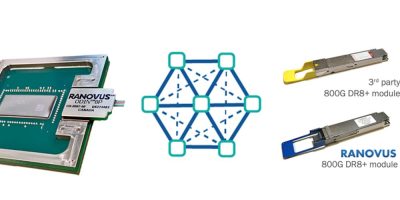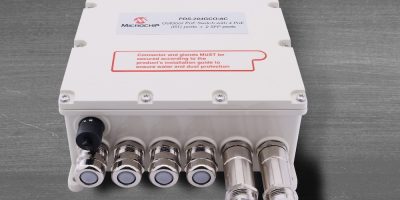At OFC, the optical communications and networking conference in San Diego, California (05 to 09 March), Ranovus has demonstrated a low power consumption, 800Gbits per second Ethernet interoperable link which is interoperable with AMD’s adaptive SoCs for AI / ML (artificial intelligence / machine learning) applications.
The Odin direct drive CPO 2.0 optical interconnect has 5pJ/bit energy efficiency and is claimed to be best-in-class for co-packaged, near-packaged optics and pluggable module form factors.
The company demonstrated interoperability of the AMD Versal adaptive SoCs with the co-packaged Odin 800G direct drive optical engine and third party 800G DR8+ retimed pluggable modules.
Ranovus’ Odin is a low latency, high density, protocol agnostic and standards-based optical engine that delivers massive optical interconnect bandwidth with industry-leading cost and power efficiency, claimed the company. Built on GlobalFoundries’ Fotonix monolithic RF / CMOS silicon photonics (SiPh) platform, Odin incorporates Ranovus’ proprietary RF CMOS, silicon photonics, laser and packaging technologies for volume manufacturing. Odin is well suited for next-generation data centre architectures built on co-packaged optics, near-packaged optics, and pluggable OSFP / QSFP-DD / OSFP XD optical modules.
Dr Christoph Schulien, head of Systems and high speed IC R&D of Ranovus, said that the inherent versatility enables hyperscale data centre providers to drastically reduce power consumption and optimise density and cost as they deploy novel hybrid data centre architectures in response to the insatiable growth in AI / ML workloads.
Yohan Frans, vice president, engineering at AMD, said: “We are proud of our collaboration with Ranovus in demonstrating the performance and versatility of monolithic silicon photonics interconnects as data centre and 5G customers deploy highly efficient and cost-effective systems for next generation workloads.”
The interoperability between CPO and pluggable modules is a key proof point that their interconnect technology supports the flexibility and scalability with the lowest power consumption sought by hyperscalers as they optimise their data centres for AI / ML workloads,” said Vladimir Kozlov the founder and CEO of Lightcounting.
Ranovus will demonstrate its Odin optical interconnect CPO, NPO and 800Gbits per second DR8+ pluggable module portfolio at the Ranovus booth 2019 and the GlobalFoundries booth 5216.







